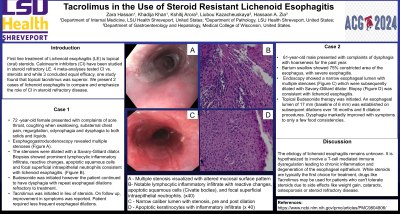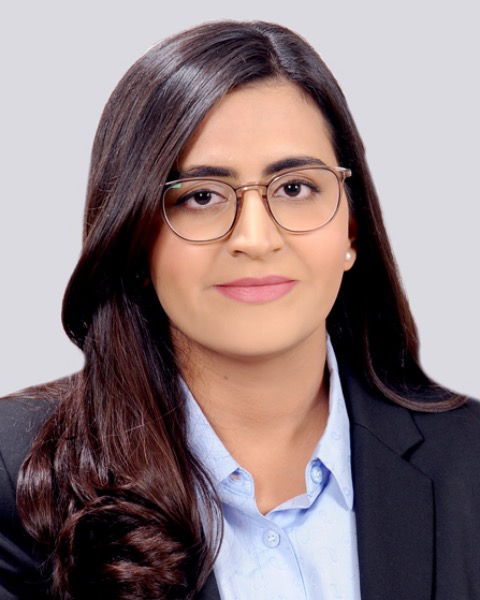Sunday Poster Session
Category: Esophagus
P0536 - Tacrolimus in the Use of Steroid Resistant Lichenoid Esophagitis
Sunday, October 27, 2024
3:30 PM - 7:00 PM ET
Location: Exhibit Hall E

Has Audio

Khadija Khan, MD
LSU Health
Shreveport, LA
Presenting Author(s)
Zara Hassan, MD1, Khadija Khan, MD2, Kshitij Arora, MD1, Liubou Kazacheuskaya, MD1, Hassaan A. Zia, MD2
1Louisiana State University Health, Shreveport, LA; 2LSU Health, Shreveport, LA
Introduction: First line treatment of Lichenoid esophagitis (LE) is topical (oral) steroids. Calcineurin inhibitors (CI) have been studied in steroid refractory LE. 4 meta-analyses tested CI vs. steroids and while 3 concluded equal efficacy, one study found that topical tacrolimus was superior. [a] We present 2 cases of lichenoid esophagitis to compare and emphasize the role of CI in steroid refractory disease.
Case Description/Methods: 1. A 72-year-old female presented with complaints of sore throat, coughing when swallowing, substernal chest pain, regurgitation, odynophagia and dysphagia to both solids and liquids. Esophagogastroduodenoscopy revealed multiple stenoses (Figure A). The stenoses were dilated with a Savary-Gilliard dilator. Biopsies showed prominent lymphocytic inflammatory infiltrate, reactive changes, apoptotic squamous cells and focal superficial intraepithelial neutrophils. PASD stain was negative for fungal microorganisms. These changes were consistent with lichenoid esophagitis. (Figure 1A). Budesonide was initiated. Despite treatment, the patient continued to have dysphagia with repeat esophageal dilations refractory to treatment. Tacrolimus was initiated in lieu of refractory esophageal stenoses secondary to lichenoid esophagitis. On follow up, improvement in symptoms was reported. Patient required less frequent esophageal dilations.
2. A 61-year-old male presented with complaints of dysphagia with hoarseness for the past year. Barium swallow showed 75% constricted area of the esophagus, with severe esophagitis. Endoscopy showed (Fig. B) a narrow esophageal lumen with multiple stenoses. The most dominant stenoses were subsequently dilated with Savary-Gilliard dilator. Biopsy (Figure 2A) was consistent with lichenoid esophagitis. Topical Budesonide therapy was initiated. An esophageal lumen of 17 mm (baseline of 6 mm) was established on subsequent dilations over 16 months and 8 dilation procedures. Dysphagia markedly improved with symptoms to only a few food consistencies.
Discussion: The etiology of lichenoid esophagitis remains unknown. It is hypothesized to involve a T-cell mediated immune dysregulation leading to chronic inflammation and degeneration of the esophageal epithelium. While steroids are typically the first choice for treatment, drugs like Tacrolimus may be used for patients who can't tolerate steroids due to side effects like weight gain, cataracts, osteoporosis or steroid refractory disease.
References:
https://www.ncbi.nlm.nih.gov/pmc/articles/PMC9804806/

Disclosures:
Zara Hassan, MD1, Khadija Khan, MD2, Kshitij Arora, MD1, Liubou Kazacheuskaya, MD1, Hassaan A. Zia, MD2. P0536 - Tacrolimus in the Use of Steroid Resistant Lichenoid Esophagitis, ACG 2024 Annual Scientific Meeting Abstracts. Philadelphia, PA: American College of Gastroenterology.
1Louisiana State University Health, Shreveport, LA; 2LSU Health, Shreveport, LA
Introduction: First line treatment of Lichenoid esophagitis (LE) is topical (oral) steroids. Calcineurin inhibitors (CI) have been studied in steroid refractory LE. 4 meta-analyses tested CI vs. steroids and while 3 concluded equal efficacy, one study found that topical tacrolimus was superior. [a] We present 2 cases of lichenoid esophagitis to compare and emphasize the role of CI in steroid refractory disease.
Case Description/Methods: 1. A 72-year-old female presented with complaints of sore throat, coughing when swallowing, substernal chest pain, regurgitation, odynophagia and dysphagia to both solids and liquids. Esophagogastroduodenoscopy revealed multiple stenoses (Figure A). The stenoses were dilated with a Savary-Gilliard dilator. Biopsies showed prominent lymphocytic inflammatory infiltrate, reactive changes, apoptotic squamous cells and focal superficial intraepithelial neutrophils. PASD stain was negative for fungal microorganisms. These changes were consistent with lichenoid esophagitis. (Figure 1A). Budesonide was initiated. Despite treatment, the patient continued to have dysphagia with repeat esophageal dilations refractory to treatment. Tacrolimus was initiated in lieu of refractory esophageal stenoses secondary to lichenoid esophagitis. On follow up, improvement in symptoms was reported. Patient required less frequent esophageal dilations.
2. A 61-year-old male presented with complaints of dysphagia with hoarseness for the past year. Barium swallow showed 75% constricted area of the esophagus, with severe esophagitis. Endoscopy showed (Fig. B) a narrow esophageal lumen with multiple stenoses. The most dominant stenoses were subsequently dilated with Savary-Gilliard dilator. Biopsy (Figure 2A) was consistent with lichenoid esophagitis. Topical Budesonide therapy was initiated. An esophageal lumen of 17 mm (baseline of 6 mm) was established on subsequent dilations over 16 months and 8 dilation procedures. Dysphagia markedly improved with symptoms to only a few food consistencies.
Discussion: The etiology of lichenoid esophagitis remains unknown. It is hypothesized to involve a T-cell mediated immune dysregulation leading to chronic inflammation and degeneration of the esophageal epithelium. While steroids are typically the first choice for treatment, drugs like Tacrolimus may be used for patients who can't tolerate steroids due to side effects like weight gain, cataracts, osteoporosis or steroid refractory disease.
References:
https://www.ncbi.nlm.nih.gov/pmc/articles/PMC9804806/

Figure: A - Multiple stenosis visualized with altered mucosal surface pattern
1A - Notable lymphocytic inflammatory infiltrate with reactive changes, apoptotic squamous cells (Civatte bodies), and focal superficial intraepithelial neutrophils. (x40)
B - Narrow caliber lumen with stenosis, pre and post dilation
2A - Apoptotic keratinocytes with inflammatory infiltrate (x 40)
1A - Notable lymphocytic inflammatory infiltrate with reactive changes, apoptotic squamous cells (Civatte bodies), and focal superficial intraepithelial neutrophils. (x40)
B - Narrow caliber lumen with stenosis, pre and post dilation
2A - Apoptotic keratinocytes with inflammatory infiltrate (x 40)
Disclosures:
Zara Hassan indicated no relevant financial relationships.
Khadija Khan indicated no relevant financial relationships.
Kshitij Arora indicated no relevant financial relationships.
Liubou Kazacheuskaya indicated no relevant financial relationships.
Hassaan A. Zia indicated no relevant financial relationships.
Zara Hassan, MD1, Khadija Khan, MD2, Kshitij Arora, MD1, Liubou Kazacheuskaya, MD1, Hassaan A. Zia, MD2. P0536 - Tacrolimus in the Use of Steroid Resistant Lichenoid Esophagitis, ACG 2024 Annual Scientific Meeting Abstracts. Philadelphia, PA: American College of Gastroenterology.
